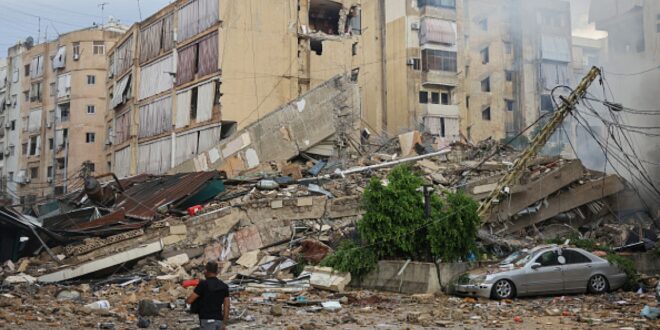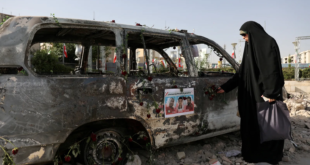Repeating its strategy of the 2006 summer war, Israel has already flattened wide areas in Beirut’s southern suburbs and elsewhere in Lebanon
Swathes of Beirut’s southern suburbs have been reduced to rubble because of the Israeli military’s near-daily bombardment of the area.
Scenes of widespread destruction are also visible in many towns and villages in south Lebanon and the Bekaa region.
Since intensifying its air strikes in Lebanon last month, Israel has repeatedly pounded urban centres as it alleges to be targeting Hezbollah sites.
But the only reason that explains the level of devastation goes beyond Israel’s claims that it is hitting Hezbollah’s weapons stored between civilians, which is the “Dahiya Doctrine”.
What is the Dahiya Doctrine?
The so-called Dahiya Doctrine is an Israeli military strategy which seeks to use disproportionate force against a hostile party.
The aim is to inflict as much destruction on civilian infrastructure and economic interests to pressure hostile governments, or in Hezbollah’s case a paramilitary group, into ultimately surrendering.
The name derives from the southern suburbs of Beirut, referred to as ‘Dahiya’ – literally ‘suburb’ in Arabic – an area which consists of multiple municipalities.
When was it founded?
The doctrine was first introduced by former Israeli army chief Gadi Eizenkot during the 2006 summer war between Israel and Hezbollah.
During the 33-day offensive, Israel flattened parts of Beirut’s southern suburbs, Hezbollah’s main bastion. That war killed about 1,200 people in Lebanon, mostly civilians.
Eizenkot had threatened to use this strategy in any future conflict with Lebanon, saying what happened to Beirut’s Dahiya “will happen in every village from which Israel is fired on”.
“We will apply disproportionate force on it [a village] and cause great damage and destruction there. From our standpoint, these are not civilian villages, they are military bases. This is not a recommendation; this is a plan. And it has been approved,” he said in 2008.
In 2024, Israel implemented this strategy across southern Lebanon, the eastern Bekaa region, and again to the south of the Lebanese capital, which has seen large displacement because of Israel’s offensive.
Under heavy attack
Beirut’s southern suburbs have been pummelled nearly every day for a week now. The city saw its first night of heavy attacks on September 27, when Israel assassinated Hezbollah leader Hassan Nasrallah.
Nearly every night since then, the densely built area has seen a series of violent strikes, where the sounds of explosions can be heard miles away and plumes of smoke fill the air.
The strikes are usually preceded by evacuation warnings from the Israeli military, marking sites and telling residents to distance themselves at least 500 meters away from the target.
Most people there have already left for safer places in Beirut or other parts of Lebanon.
But strikes have not been limited to the sites warned about – the Israeli military continues to bombard the ‘Dahiya’ into the next day. For example, the military would warn about three sites but proceed to carry out several more attacks.
Some nights have seen between 20 and 30 strikes conducted across the southern suburbs.
Many blocks have been laid to waste, and surrounding streets are usually heavily damaged.
Used in Gaza
The Dahiya Doctrine has been used in the Gaza Strip, which Israel has destroyed in its year-long war on the Palestinian enclave.
Virtually not a single across the territory has been spared the bombs.
Most of the Gaza Strip’s roughly 2.3 million people have been displaced, with much of the population being forced to move south.
The strategy has been used by Israel in all its wars on Gaza – 2008, 2014, and the current war which erupted on October 7.
What does international law say?
International humanitarian law bans the use of disproportionate force and the targeting of civilians and civilian infrastructure during war.
Article 51 of Geneva Protocol I prohibits bombardment that treats a number of clearly separated and distinct military objectives located within a city as a single military target.
“Applying the principle of proportionality is critically important for protecting civilians and critical infrastructure in situations of armed conflict,” according to the International Committee of the Red Cross.
“An attack against a military objective can be lawful only if the principles of proportionality and precautions are respected, meaning that the incidental civilian harm must not be excessive, and the attacker must have taken all feasible precautions to avoid this harm or at least reduce it,” says the ICRC.
The Lebanese health ministry said Tuesday that 2,119 people have been killed and another 10,019 wounded in Lebanon since hostilities began with Israel a year ago.
The toll includes Hezbollah fighters and civilians, among them children, rescuers, and health workers.
The number of those killed could be higher. Civil defence workers and paramedics have been unable to go into many areas bombed by Israel, fearing they could be targeted.
 Eurasia Press & News
Eurasia Press & News


